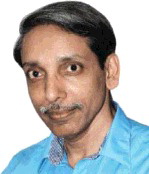The current issue of the IETE Technical Review (Vol. 33, No. 5, September–October 2016) contains nine articles. These articles present a survey as well as original research in the areas of communication engineering, image compression, signal processing, antennas and sensors.
Compressed sensing (CS) can sample as well as compress signals simultaneously. However, when the size of the signals is large, it can result in increased signal reconstruction time of CS algorithms and also affect the growth rate of the reconstruction time. In ‘A Fast Algorithm of Compressed Sensing for 2D Signals’ by Yongping Zhang, Gongxuan Zhang and Zhaomeng Zhu, the authors propose a fast CS algorithm, called the block whole orthogonal matching pursuit (BWOMP) based on the method of orthogonal matching pursuit (OMP) for two-dimension (2D) signals. Using experimental comparisons, the authors demonstrate that in comparison with OMP, BWOMP can save at least 80% reconstruction time leading to a great performance advantage for complex cases.
The work reported in ‘A New Approach for Stability Analysis of Discrete Systems’ by Vilas H. Gaidhane and Yogesh V. Hote is based on the algorithm for reduced conservatism of eigenvalues and the Gerschgorin circle theorem. The authors mathematically prove the necessary and sufficient condition for conservatism of eigenvalues of matrix and compare with the other existing methods to demonstrate the usefulness of their approach.
In the paper ‘Performance Analysis of Adaptive Array Signal Processing Algorithms’, Abhinav Sharma and Sanjay Mathur evaluate different direction of arrival (DOA) estimation and adaptive beamforming (ABF) algorithms. Using simulation results, the authors arrive at two conclusions: (a) multiple signal classification (MUSIC) algorithm provides more accurate and stable results and (b) recursive least square (RLS) algorithm shows the fastest convergence rate among other beamforming algorithms. The authors suggest that adaptive antenna could potentially be used in cognitive radio and orthogonal frequency division multiple access (OFDMA) systems.
Object recognition, motion tracking, simultaneous localization and mapping and stereo vision are important activities in various higher level computer vision applications. A superior feature detector in terms of computational speed is called the feature from accelerated segment test (FAST). In the paper, ‘Speed-up Feature Detector using Adaptive Accelerated Segment Test’, Yenewondim Biadgie and Kyung-Ah Sohn report a new method to speed up the FAST detector and also provide a review of similar feature detectors.
For static images and dynamic image sequences, how does one extract the facial features? How does one classify these extracted facial expressions? These are very important questions in facial expression recognition, an area of research which is fast growing. Xiaoming Zhao and Shiqing Zhang address these two questions extensively in their paper entitled ‘A Review on Facial Expression Recognition: Feature Extraction and Classification’.
Can we detect drowsiness with eyes open? The paper ‘Neural Network Based Detection of Drowsiness with Eyes Open using AR Modelling’, by Hyungseob Han and Uipil Chong, examines this question using power spectrum analysis and auto-regressive modelling. In their work, they classify alertness, transient, and drowsy periods according to alpha spectrum changes and alpha-blocking phenomena. The demonstrate that ‘LPC (linear predictive coding) coefficients are the proper feature vectors and average classification rate is about 92%’.
For extraction, utilization and dissemination of knowledge, there are tools such as the Knowledge management system (KMS). KMS responds to the queries of clients and provides a response. In a paper entitled ‘Automated Knowledge Provider System with Natural Language Query Processing’, Prasenjit Mukherjee and Baisakhi Chakraborty propose an automated knowledge provider system (AKPS) that accepts a natural language request of a user and uses a grammatical rule-based automated model. By mapping the natural language query into the physical data model, the proposed AKPS can send responses to the user from a database.
Sangram Panigrahi, Kesari Verma and Priyanka Tripathi in their paper entitled ‘An Efficient Approach to Detect Sudden Changes in Vegetation Index Time Series for Land Change Detection’ propose a novel Recursive Search Algorithm (RSA) ‘to detect sudden changes in time series data-set’. Although there are different methods reported in literature for detecting sudden changes, they suffer from a main drawback. They can only identify if a time series is changed or identify the changed segment only. The authors demonstrate that the proposed approach has ‘the capability to detect with high confidence to correctly compute the change point (time of change) in time series data, also detect the type of change (increase/decrease) occurred in series’. They further show that the proposed algorithm is scalable by performing experiments on synthetic data-set.
The positioning precision of piezoelectric actuators (PZAs) is dependent on the hysteresis nonlinearity. To overcome this problem, Miaolei Zhou, Peng Yang, Jingyuan Wang and & Wei Gao describe an adaptive sliding mode control method in the paper entitled ‘Adaptive Sliding Mode Control Based on Duhem Model for Piezoelectric Actuators’. They demonstrate that using the proposed method efficiently controls hysteresis behaviour of PZAs and results only in a maximum relative error of 0.57%. This has the potential to improve the positioning precision of PZAs.
Additional information
Notes on contributors

M. Jagadesh Kumar
Mamidala Jagadesh Kumar is a Professor of Electrical Engineering at the Indian Institute of Technology, New Delhi, India. He is also the Vice-Chancellor of Jawaharlal Nehru University, New Delhi, India. He was an Editor of IEEE Transactions on Electron Devices from 2006 to 2015. He is an Editor of IEEE Journal of the Electron Devices Society. He has widely publishedin the area of Micro/Nanoelectronics and is known for his excellence in teaching. He is a member (PT) of Telecom Regulatory Authority of India (TRAI). More details about Dr. Kumar can be found at http://web.iitd.ac.in/»mamidala
Email: [email protected]
